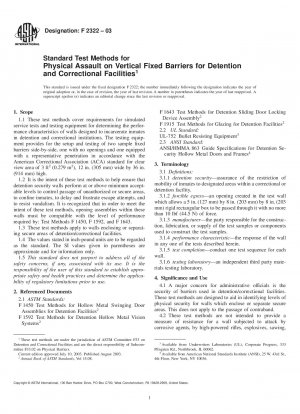ASTM F2322-03
Standard Test Methods for Physical Assault on Vertical Fixed Barriers for Detention and Correctional Facilities
- Standard No.
- ASTM F2322-03
- Release Date
- 2003
- Published By
- American Society for Testing and Materials (ASTM)
- Status
- 2012-01
- Replace By
- ASTM F2322-12
- Latest
- ASTM F2322-12(2019)
- Scope
A major concern for administrative officials is the security of barriers used in detention/correctional facilities. These test methods are designed to aid in identifying levels of physical security for walls which enclose or separate secure areas. This does not apply to the passage of contraband.
These test methods are not intended to provide a measure of resistance for a wall subjected to attack by corrosive agents, by high-powered rifles, explosives, sawing, or other such methods. These test methods are intended to evaluate the resistance of a wall to violent attacks by sustained manpower using battering devices, such as benches, bunks, or tables, and by handguns up to and including .44 magnum. Attacks from the outside and fire resistance ratings are not addressed in this standard.
The primary purpose or result of these test methods is to approximate the levels of abuse to which walls will potentially be subjected in the field. The desired result of its use is to help provide assurance of protection to the public, to facility administrative personnel, and to the inmates themselves.
It is recommended that detention/correctional facility administration provide adequate training, supervision, and preventative maintenance programs to enable walls to function as intended throughout the expected service life.
1.1 These test methods cover requirements for simulated service tests and testing equipment for determining the performance characteristics of walls designed to incarcerate inmates in detention and correctional institutions. The testing equipment provides for the setup and testing of two sample fixed barriers side-by-side, one with no openings and one equipped with a representative penetration in accordance with the American Correctional Association (ACA) standard for clear view area of 3 ft2 (0.279 m2), 12 in. (305 mm) wide by 36 in. (914 mm) high.
1.2 It is the intent of these test methods to help ensure that detention security walls perform at or above minimum acceptable levels to control passage of unauthorized or secure areas, to confine inmates, to delay and frustrate escape attempts, and to resist vandalism. It is recognized that in order to meet the intent of these test methods, opening assemblies within these walls must be compatible with the level of performance required by: Test Methods F 1450, F 1592, and F 1643.
1.3 These test methods apply to walls enclosing or separating secure areas of detention/correctional facilities.
1.4 The values stated in inch-pound units are to be regarded as the standard. The SI values given in parentheses are approximate and for information only.
1.5 This standard does not purport to address all of the safety concerns, if any, associated with its use. It is the responsibility of the user of this standard to establish appropriate safety and health practices and determine the applicability of regulatory limitations prior to use.
ASTM F2322-03 Referenced Document
- ASTM F1450 Standard Test Methods for Hollow Metal Swinging Door Assemblies for Detention Facilities
- ASTM F1592 Standard Test Methods for Detention Hollow Metal Vision Systems
- ASTM F1643 Standard Test Methods for Detention Sliding Door Locking Device Assembly
- ASTM F1915 Standard Test Methods for Glazing for Detention Facilities
ASTM F2322-03 history
- 2019 ASTM F2322-12(2019) Standard Test Methods for Physical Assault on Vertical Fixed Barriers for Detention and Correctional Facilities
- 2012 ASTM F2322-12 Standard Test Methods for Physical Assault on Vertical Fixed Barriers for Detention and Correctional Facilities
- 2003 ASTM F2322-03 Standard Test Methods for Physical Assault on Vertical Fixed Barriers for Detention and Correctional Facilities
